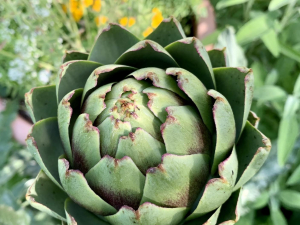
Artichokes seem complicated, but steaming them is a very simple technique, especially if you don’t bother cutting off the prick found at the tip of each individual “scale”. (Go ahead and cut them off if you want it to look prettier and to avoid any unexpected pricks.) I like to steam them or pressure cook them which takes 20 or 10 minutes, respectively.
Eating an artichoke after it is steamed is maybe the most complicated part about it, but this, too, is actually quite simple. Begin at the bottom row and start to peel each scale, then slide the bottom part only through your teeth. There is a very little meat on the scales initially, but as you get closer to the heart, you will have more and more substance on each leaf. Anyway, the best part (my opinion) is to dip each scale (bottom half only) into a dip. Any kind of dip will do – vinaigrettes, mayo-cream, butter-lemon, etc. I like a herbaceous green goddess type sauce. This way of eating an artichoke gets messy as you get to the heart, so have napkins handy!
The Macau variety (Bretagne) of artichoke is great for eating. We just starting harvesting some from our garden, and what a treat they are! Did you know that if you don’t harvest the artichoke, it will transform into a beautiful purple flower? We mostly eat them, but do leave a few to flower.
Ingredients for 4 people
4 large Macau artichokes (or green globe artichokes)
Salt for water (and optionally a bay leaf if you like)
Sauce
½ cup mayonnaise
½ cup Greek yogurt
Freshly chopped herbs to taste (chives, parsley, chervil, tarragon, coriander)
Red onion, sliced very finely
Splash of tobacco, or to taste
Salt, piment d’Espelette (or Cayenne)
Freshly squeezed lemon juice
Zeste of lemon
Steps
- Prep artichokes:
- Fill large bowl with cold water and add a good quantity of white vinegar. Put artichokes in the water and let sit about 10 minutes to encourage the little ants and such to leave the plant. Remove from the water bath.
- Leave stem on but cut a thin slice off the bottom. Leaving about 2-3 inches of stem is usually good. Remove outer layer of stem with a knife, starting at the cut end and going toward the bulb. Rub with lemon juice if you want to try to prevent discoloration (but it gets discolored anyway!).
- Throw together the Sauce:
- Put all ingredients into a bowl. Season, taste and adjust as needed.
- If you want to have a super smooth sauce, run it through a mini food processor.
- Put sauce into 4 individual ramekins (quantity desired).
- Cooking artichokes:
- Get a big pot of water ready – big enough to hold all 4 artichokes and fill about halfway. Bring to boil. Add lots of salt (so that it tastes like the sea).
- Add the artichokes. I don’t worry about getting them fully submerged – whatever isn’t under water will be steam cooked! Cover.
- Let cook about 20 minutes. Pierce stem with thin blade knife to see if it is soft. There should be no resistance. If it feels slightly hard, return to pot and cook until soft. Actual time varies depending on size.
- Remove from water and let heat dissipate. They can be served cold, room temperature or slightly warm. Your choice!
- Serving.
- Serve in a bowl. Bring a big “garbage bowl” to the table for the discarded scales. Remove one leaf at a time. Dip into sauce only the end that you’ve just torn from the stem. Scrape the dipped end of the leaf through your top and bottom teeth. You don’t actually eat the leaf! Be careful NOT to eat the end with the prick.
- Repeat until you get to the softest part. You won’t get much of anything initially, but as you get closer to the heart, you will be rewarded.
- Once you get to the most tender leaves, you are close to the heart. Remove the furry part, using a spoon. If it is a baby artichoke, it is edible, otherwise throw away. You should be left with the heart. Cut up and dip, too! Enjoy!
